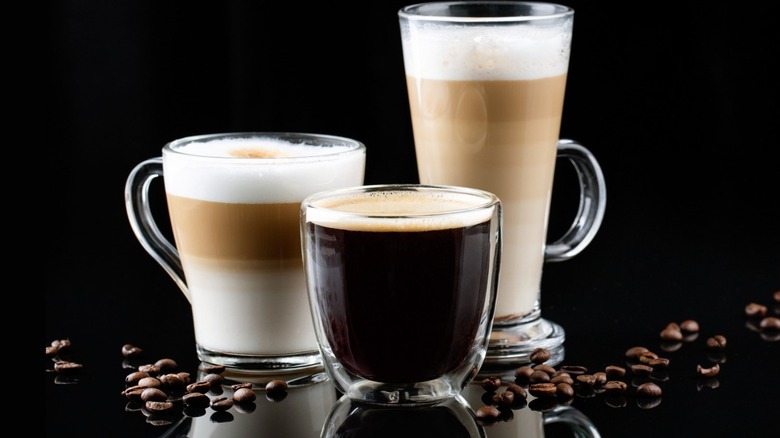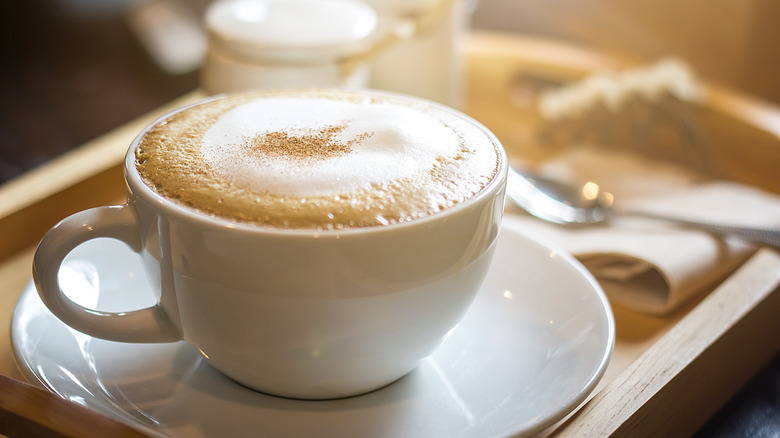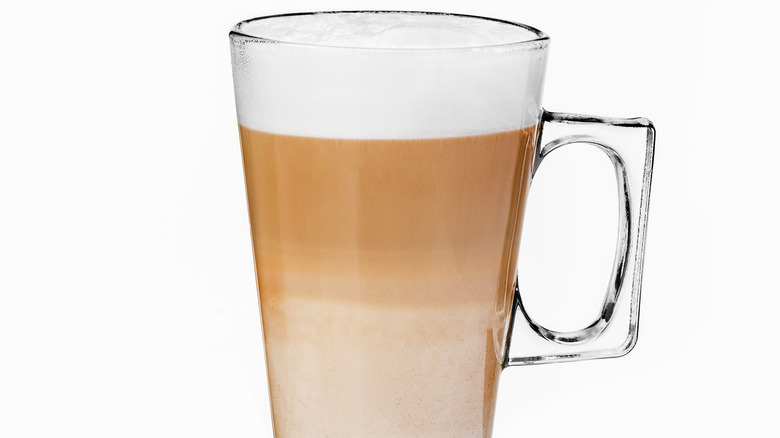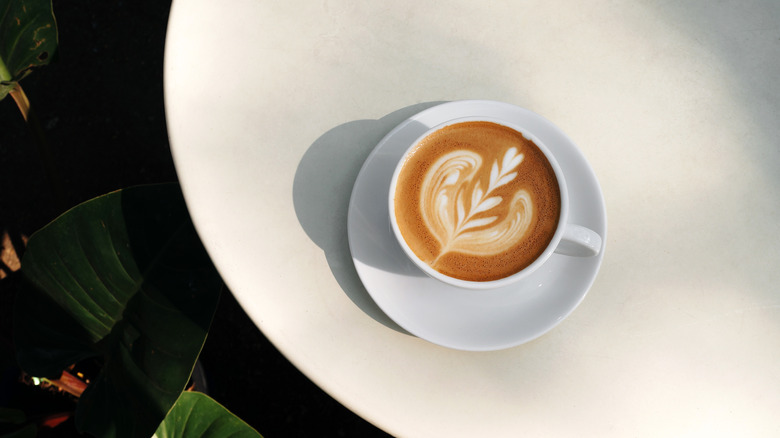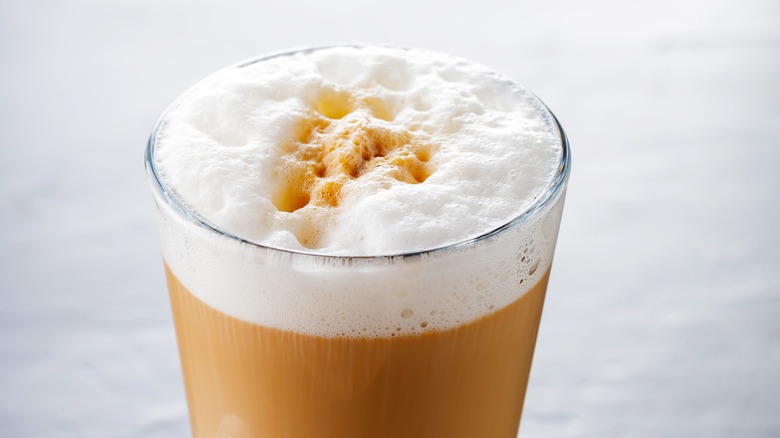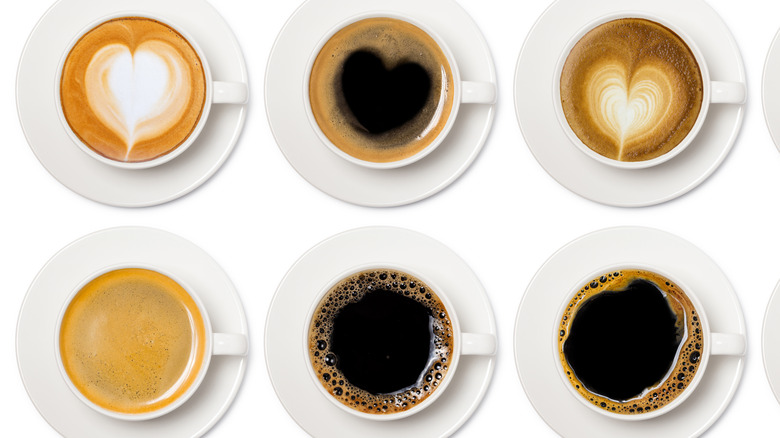What Is The Difference Between A Macchiato, A Cappuccino, And A Latte?
In all of its many iterations, coffee has become so much more than just a regular beverage. As evidenced by the hordes of "don't talk to me until I've had my coffee" memes, as well as the advent of big-name café chains, and the round-the-clock nature of morning brews and after-dinner espressos, it has simply become a cultural and gastronomic mainstay. It's iconic, far-reaching, and a salve for many. For some, though, a quick "cup of joe" is all that's necessary to get some pep in their step. For others, the world of espresso drinks is a rich tapestry of possibilities — especially when sweeteners, syrups, dairy and non-dairy choices, and other add-ons are included. But, if you're not sure what differentiates one drink from another, look no further.
In almost every type of espresso drink (sans the Americano), there is usually some ratio of espresso, milk (dairy or non-dairy), and possibly a foam topping. In some instances, ground cinnamon may be added as the perfect finishing touch, or perhaps a dollop of whipped cream. Some may be purists when it comes to hot espresso drinks, while others will strictly only drink iced versions. Some still may insist on taking their drink straight, while others may mix in copious amounts of sugar or simple syrup to maximize the flavor profile.
You may even have a tried-and-true cup of coffee or an espresso drink next to you while you're reading this. But, if you're still curious, here are the tried-and-true differences between the main staples — lattes, cappuccinos, and macchiatos.
What is a cappuccino?
Arguably the most "well known" of all the espresso drinks, the cappuccino is defined by Nescafé as a mix of espresso, steamed milk, and foam, and is "all about the structure and the even splitting of all elements into equal thirds." The cappuccino can be a deft balancing act: Too much espresso, and the drink can be overpowering; too much milk and it might seem diluted; and too much foam and it could come off as excessive or unsatisfying.
Nescafé further notes that the cappuccino originated in the 1980s in Italy before spreading through Europe and eventually coming to the U.S. The Spruce Eats, however, says that the cappuccino may date back as early as the late 1700s, though the espresso machine itself wasn't invented until the early 1900s, making the cappuccino we all know and love today a byproduct of the modern espresso machine.
The precision of the perfect cappuccino
The name cappuccino is a play on the "hue of the Capuchin friar robes," according to Nescafé – the clothing is said to be reminiscent of the layering and coloring of a traditional cappuccino, seen in the disparity between the dark richness of the espresso and the airy lightness of the milk and foam. Serious Eats poetically describes a cappuccino as, "When expertly poured, so that a circle of white is perfectly encircled by the darker coffee, the design on a traditional cappuccino is called a monk's head."
As noted by Home Grounds, the drink is strictly consumed in the mornings in Italy. Of course, this is not the case in the U.S. where it's enjoyed all day long. And, believe it or not, there's an Italian institution called Istituto Nazionale di Espresso Italiano, which explicitly states a recipe for the "certified Italian cappuccino," made with "25 ml espresso, 100 ml cold milk steamed to a volume of 125ml, served in a white porcelain cup, and topped with a visible dome-shaped cap of milk foam" (per Home Grounds). Now that's precise!
What is a latte?
A latte, on the other hand, is characterized by a higher quotient of steamed milk, with a very light layer of foam. In fact, café latte literally translates to "coffee milk." The drink is also characteristically mixed, as noted by Coffee Bean & Tea Leaf, whereas the cappuccino is layered and then consumed as is. It should also be noted that any of these drinks can be made with numerous espresso shots, too — most are made with a single or double shot, but some large iced espresso drinks may contain up to four or five, and it can also vary depending on preference for taste and strength. A cappuccino in general has less milk than a latte, so it's slightly less caloric, according to Healthline.
In most iterations, lattes contain much more milk than coffee. Latte art is a conversation for another day, but some incredibly talented baristas can truly produce works of art with the steamed milk. Furthermore, it should be noted that ordering any of these drinks in various countries may result in an entirely different experience, i.e a latte in the U.S. may be wildly different than a latte in France, according to Home Grounds.
What is a macchiato?
Perhaps the least ubiquitous of the espresso beverages is the macchiato, which means "marked" in Italian, and denotes the delineation of dark espresso that can be seen on the top of the foamed, frothed milk. You may also hear someone order an "espresso macchiato," but that's a bit of a misnomer because all macchiatos contain espresso.
Technically, a macchiato is just a single shot with a touch of milk, but the type of drink that many consume today throughout the U.S. is technically a "latte macchiato," which Home Grounds notes as being "inverse" where the hot milk is topped with espresso, and is usually larger and served in a large glass. This non-traditional macchiato — which you might get at Starbucks or Dunkin' — is characterized by a base of milk, topped with steamed milk or foam, and then "marked" by espresso shot(s). The delineation of the dark espresso is juxtaposed by the purity of the steamed milk, hence the name.
Home Grounds also states that additions such as sweeteners, cinnamon, or chocolate may have originally been added due to poor quality espresso beans used in wartime Italy. When using quality espresso, though, there's not much need for anything else to gussy up the drink: It's pristine all on its own.
Comparing the three drinks side-by-side
A latte and a cappuccino are rich, smooth, and creamy, while a traditional macchiato can be a bit stronger and/or more acidic due to less milk. A traditional macchiato is also much smaller than a latte or cappuccino, usually just over 1 ounce, according to Healthline. Of course, all of these drinks are chock-full of caffeine, but they're also balanced with a bit of fiber and protein. It's also important to note the difference between foamed, frothy milk and coffee crema, the latter of which The Spruce Eats notes is a "flavorful, aromatic, reddish-brown froth that rests on top of a shot of espresso."
Coffee culture is distinct and personalized, from country to country, café to café, and home to home. No matter what, though, they're all delicious, whether you're starting your day with a traditional cappuccino or enjoying a rich, sweet Starbucks caramel macchiato as a dessert.
Now go forth with the confidence to order precisely what you'd like the next time you stop into a coffee shop, or the next time you're whipping up some java at home.
